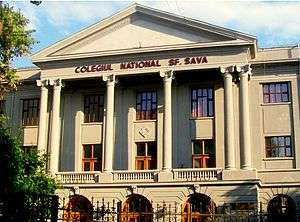Saint Sava National College
| Saint Sava National College Colegiul Național Sfântul Sava | |
|---|---|
 | |
| Address | |
|
General Berthelot Street no. 23 Bucharest Romania | |
| Coordinates | 44°26′27.6″N 26°05′28″E / 44.441000°N 26.09111°E |
| Information | |
| Funding type | Public |
| Established | 1688 |
| Status | Open |
| Category | High School |
| Grades | 9 to 12 |
| Gender | coeducation |
| Age range | 14-19 |
| Enrolment | cca. 1000 |
| Average class size | 30 |
| Medium of language | Romanian |
| Hours in school day | 5-7 |
| Campus type | Urban |
| Nickname | CNSS |
| Alumni |
|
| Website |
licsfsava |
The Saint Sava National College (Romanian: Colegiul Național Sfântul Sava), Bucharest, is the oldest and the most prestigious high school in Romania.[1]
The College is the direct descendant of the Princely Academy of Saint Sava, which was divided in 1864 by Prince Alexandru Ioan Cuza into the University of Bucharest and the present high school. During the Communist era, its name was changed to Nicolae Bălcescu High School.
The name of the College comes from the Monastery of Saint Sabbas the Sanctified in Bucharest, in which it has been founded. To this day, it celebrates its birthday on 5 December, the feast day of Saint Sabbas the Sanctified.
History
In the 17th century Saint Sava was actually an old monastery built in Bucharest’s historic centre, in the proximity of today’s University Square. It was in the rooms of this monastery that Romania’s first higher education institution was set up. The founding of this college in the late 17th century was brought about by a strong European influence, mostly Italian, that encouraged the rise of the national spirit. This assertion of a national awareness had the firm support of many writers and historians of the age.
In Wallachia (Southern Romania) the most remarkable representative of this trend was Constantin Cantacuzino, a writer and a great patriot, who had been educated in Padua, Italy. He was a widely−travelled aristocrat and adviser to Prince Șerban Cantacuzino. "As Constantin Cantacuzino was determined to have a college similar to the Italian ones set up in Bucharest, his brother’s coming to power in 1678 made it possible for him to achieve his goal" (Nicolae Iorga, Romanian historian, 1871-1940). "Saint Sava Princely Academy" was therefore created by Wallachia’s reigning Prince Şerban Cantacuzino and it was placed under the aegis of the Prince and of the Patriarch of Jerusalem. Cultural and religious allegiance accounted for the fact that tuition was carried on in modern Greek, a symbol of Byzantine civilization.
The first principal of the school was Sebastos Kyminitis, who had been educated in Constantinople. Saint Sava Academy thrived during the reign of Constantin Brâncoveanu’s, who sketched out the curriculum and ensured the funds needed to run the school. A law given in 1707 demanded that "teachers should be understanding and principled; they should also have excellent reputation".
Notable teachers (includes teachers at the Princely Academy)
References
- ↑ Pitigoi, Victor. "O scoala romaneasca incarcata de istorie: Sfantul Sava". Ziare.com. Retrieved 17 March 2018.
External links
- (in Romanian) Official site